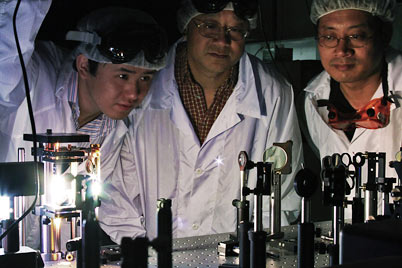A significant breakthrough in remote sensing, carried out by a team of researchers from New York University, paves the way for the detection of explosives, chemical and biological substances and illegal drugs hidden from a distance of twenty meters.

Terahertz waves occupy a large segment of the electromagnetic spectrum, are between the segments of infrared light and microwaves and are able to provide sensing and imaging methods that are not currently available such as X-rays and microwaves.
The ability to remotely sense using terahertz waves has been known for many years, but the development of their practical application has been delayed due to the fact that the presence of moisture in the background of the environment interferes with the movement of the waves," explains Xi-Cheng Zhang, Director of the Terhertz Wave Research Center at Rensselaer University. The research findings were published in the scientific journal Nature Photonics.
The completely optical system for remote sensing using terahertz waves uses laser-induced fluorescence, by focusing two laser beams together and projecting them into the air while remotely creating an ionized substance (plasma) that reacts with the terahertz waves. The fluorescence of the plasma transmits information from the target material to the detector, where an immediate comparison is made against a spectrum library of materials and a quick detection of the nature of the material being tested remotely.
"We showed that it is possible to focus a laser beam at a wavelength of 800 nm with a laser beam at a wavelength of 400 nm towards the air to remotely create a plasma capable of reacting with the terahertz waves, and to use the fluorescence emitted from this interaction to transmit information back to a local detector," he explains the researcher
Frequent terrorist threats and the thwarting of the Christmas Eve bombing attempt gave rise to increased interest in the development of remote sensing capabilities by terahertz waves at the American airline company Northwest, funded by the Ministry of Defense and the Department of Homeland Security in the USA.
Since terahertz waves pass through almost anything that is not metal or liquid, these waves are able to "see through" most materials that may hide explosives or other dangerous materials, materials such as packaging items, cartons, fabrics, shoes, backpacks and book bags.
Unlike X-rays, terahertz radiation does not pose any health risks. However, the method is not able to locate substances hidden in the body cavities.
"Our method will not help diamond mine owners in Africa who want a system to prevent their workers from smuggling diamonds by swallowing them," explains the researcher.
Although most of the research was conducted in a laboratory setting, the system is portable and could eventually be used to check for the possible presence of explosives, hazardous materials or illegal drugs hidden in backpacks or cargo abandoned at airports. On the battlefield, the system will be able to locate the hiding place of the explosives.
The fact that each and every substance has a unique fingerprint in the spectrum of terahertz waves will lead to the precise identification of the hidden compound or compounds - an ability that should have multiple effects and unexpected uses. In the case of a chemical spill, for example, remote sensing will allow identification of the composition of the toxic mixture without endangering people.
"I estimate that within a few years the science and technology of terahertz waves will become more available and practical for industrial and defense uses," predicts the lead researcher.

One response
Sounds casual if it doesn't penetrate barriers